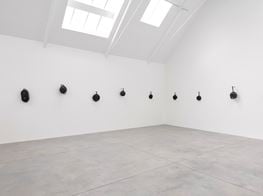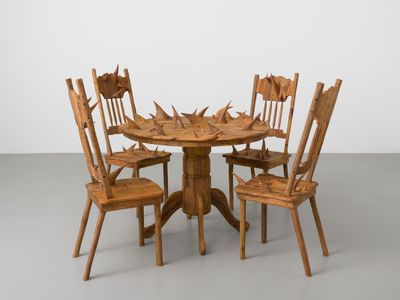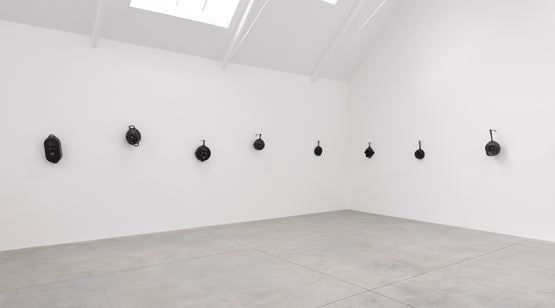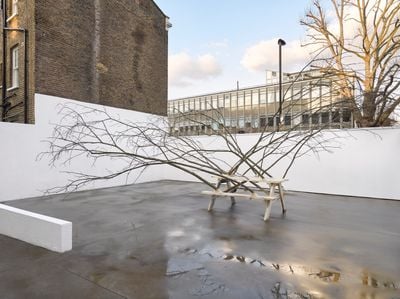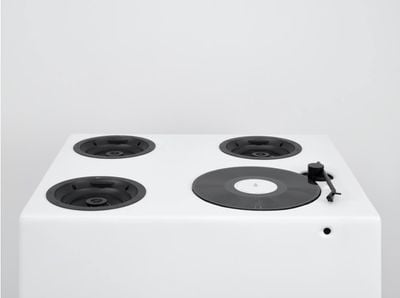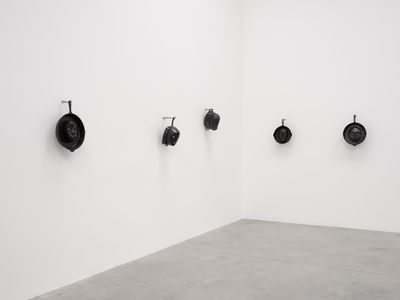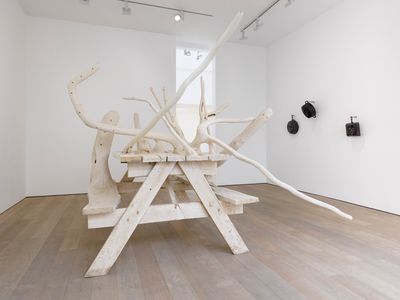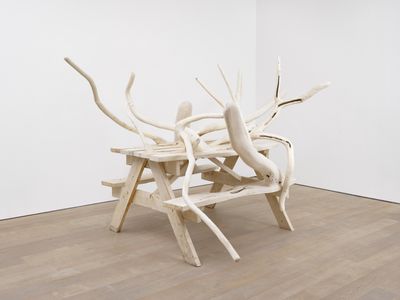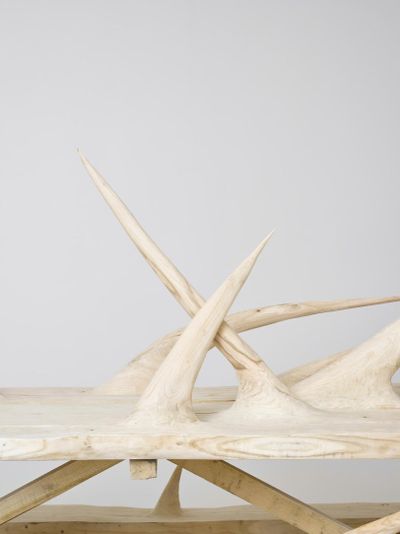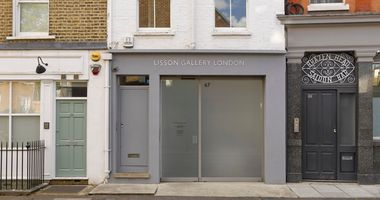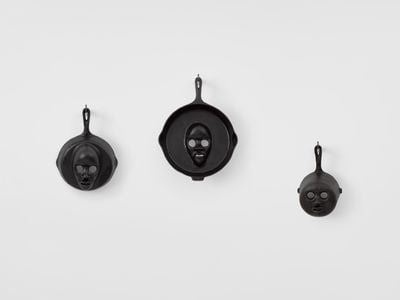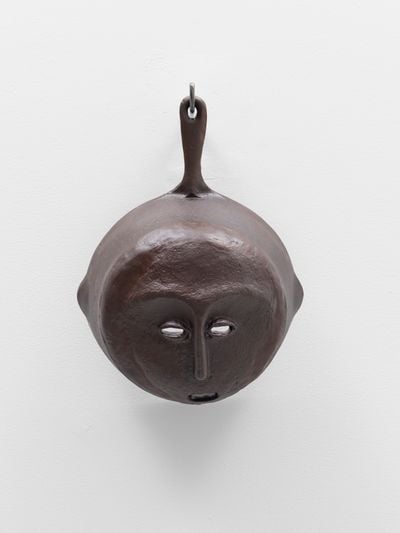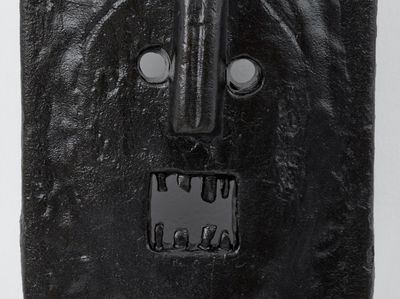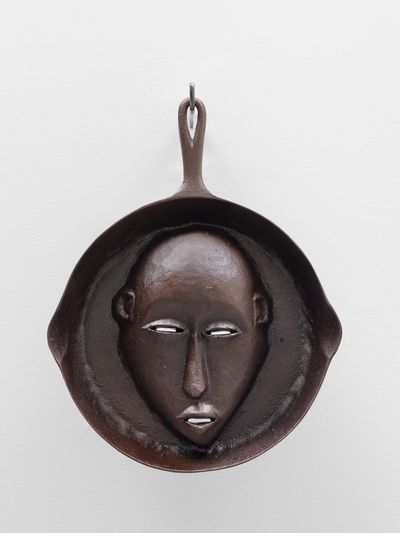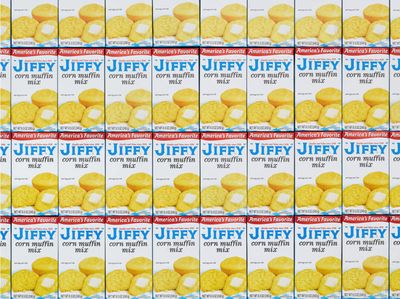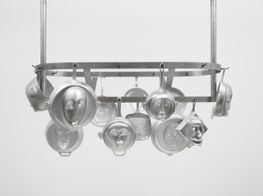Hugh Hayden: Questions of Authenticity
In partnership with Lisson Gallery
Hugh Hayden. © Hugh Hayden. Courtesy Lisson Gallery. Photo: William Jess Laird.

Hugh Hayden. © Hugh Hayden. Courtesy Lisson Gallery. Photo: William Jess Laird.
Originally trained as an architect, Hugh Hayden creates large-scale sculptures and culinary installations that consider questions of history and identity in contemporary America through organic materials such as wood.
The artist's sculpture Zelig (2013), for instance, which featured in Hayward Gallery's exhibition Among the Trees (4 March–17 May 2020), resembled two small logs from afar, placed one on top of the other. Upon closer inspection, however, one log revealed itself to be covered in small Sharptail grouse feathers that Hayden collaged on its surface. Speaking in a video for Hayward Gallery, the artist explained that the work is him 'trying to remix nature' to explore the notion of assimilation, and the assigning of people to various demographics—be it gender, religion, wealth, or race.
Hayden's penchant for tampering with appearances was furthered in his recent solo exhibition curated by Alex Bacon and Mitra Abbaspour at Princeton University Art Museum, Creation Myths (18 January–7 June 2020), which interacted with the domestic spaces of Bainbridge House.
The house, which has been used as student accommodation, the residence of a historical society, and for a fleeting moment the seat of Congress, was reimagined through a series of interconnecting domestic spaces. In the 'dining room', Hayden carved a thorn-covered table out of wood; thorns being a symbol of the American Dream throughout Hayden's work, referencing its unattainability. In the 'kitchen', Hayden presented a series of cast-iron skillets combined with impressions of African masks to consider the legacy of American cuisine as originating in the South, where enslaved cooks helped define it.
For American Food, Hayden's first solo exhibition in the U.K. at Lisson Gallery in London (12 March–31 July 2020), the artist presents another series of cast-iron skillets, alongside three signature tables and chairs resembling those found in pub beer gardens in the U.K., their titles, Can't we all just get along, Communion, and Honorary Natives and the elephant in the middle of the room (all 2020), reflective of their thorny aspirations.
Also included in the exhibition are two panels mounted with a series of boxes of Jiffy Corn Muffin Mix—one of America's most popular brands of readymade cornbread, a traditional Southern cuisine—along with an installation resembling a stove in which hobs have been replaced by speakers, which play a recording of Hayden cooking and eating bacon.
In this conversation, Hayden talks about his London show and how it relates to his practice with curator and lecturer Elvira Dyangani Ose, who joined The Showroom in London as director in 2018 from her role as Senior Curator at the New York-based non-profit public arts organisation Creative Time. The discussion is an edited transcript of a live talk that took place online on 8 July 2020.
EDOCould you expand on the origins of your exhibition American Food at Lisson Gallery?
HHThis show is interested in the African cultural origins connected to America, and is conceptually thinking about foundational elements of the United State's economic infrastructure in terms of entertainment, and culture at large. The show is structured spatially into different rooms, including a kitchen, where there is a stove that has a recording of me cooking bacon, Rhythm (2020), and then in the main 'pantry' space, there are 26 cast-iron skillets that I created in collaboration with a foundry in New York.
When you enter the space, the skillets engulf you. They are cast from collages of actual skillets—some of them are about 200 years old—coupled with a variety of different types of wooden African masks, primarily from West Africa; a lot of them are from the Lega tribe, along with the Kwele tribe, in Gabon. Before firing them, the skillets were seasoned with grapeseed oil, which is a traditional way of curing and sealing metal. That's what creates all these hues; none of them are actually black. You could say they range in shades of brown to black.
EDOWhere did this idea of casting these masks come from?
HHWhen sourcing the different masks, there's always a question of authenticity. How African is it? Or, how real is it? How old is it? Is it a tourist object? Is it fake? Because I use a traditional sand-casting method, there's an intentional loss of information. It's not perfect like with lost-wax casting. So I am essentially abstracting these original forms.
For me, it didn't matter so much how authentic the masks were, as a Black person in the U.S. I consider it as an intentional diaspora. Also, they're no longer wood, which was the original connection between my works, and most of the masks originate from West Africa, which is where most Black people in the United States have come from historically. There's an intentional loss of information and distortion in casting them that to me reflects the American experience.
A piece of lumber isn't this abstract thing that just arrives like a hamburger—it really has bones.
EDODistortion, as you say, is very much part of your work. You make this beautiful reference to the Middle Passage as being abstracted in a similar way to how your materials have been abstracted. Can you tell us a little bit more about that?
HHI'm interested in this notion of African cultural origins and the creation of America. The skillets and more widely this show, is not about enslavement—it's about looking at cooking as a conceptual act of creating something new, and doing that by referencing cultural origins. A skillet, pot, or pan is one of the foundations for cooking and creating something. There's also the notion of sustenance: eating something to create nourishment to survive.
EDOYou talk about cooking as a form of conceptual art, but it also provides a moment of sharing—it is something that you offer almost as a ritual to other people. I wonder if you can talk a little bit more about these culinary experiences that perhaps are less known of your practice?
HHI now call them culinary installations, but they originated from the intimate act of entertaining friends over dinner. I went to an all boys' Jesuit school in Dallas that has a sister school called Ursuline, and a group of my friends from the two schools would get together and hold these impromptu dinners where we'd make something unusual, like lamb with mint jelly. Fast forward to when I went to Cornell, the dinners became a little more thematic and there would be different cuisines, like Japanese.
At the same time, studying architecture, I wanted to take this act of eating beyond being a decorative interior experience and create something that was more invasive, or more involved in heightening that experience. The resulting dinner parties were focused on taste by eliminating the texture of the food and every distraction, so guests had to wear all white. I told them what to bring, which always involved ubiquitous flavours such as banana split, green beans, cheeseburger, or buffalo wings. We'd curate everything in advance, then serve it back to everyone in a tube. I was interested in the recontextualisation of these nostalgic, quintessential tastes, like Oreos and milk or McDonald's chicken nuggets.
EDOThe table—and the kitchen table specifically—has featured previously in your practice as a symbol of the American Dream. How does the culinary and this symbol of the table relate to the history of social politics in America in your practice?
HHAs the dinner parties evolved, they went beyond the food and instruments on the table, and I started making custom-made tables to enhance the experience of a meal. The picnic table, for example, is typically public, which points to a communal experience. In a lot of public scenarios and even in a family setting, however, it can be difficult to engage with the people sitting at the table, and I wanted to capture that in the table sculptures showing at Lisson Gallery.
The skillets and, more widely, this show, is not about enslavement—it's about looking at cooking as a conceptual act of creating something new, and doing that by referencing cultural origins.
Can't we all just get along, for example, references Rodney King's famous question. George Floyd hadn't been murdered when I made this piece—I started working on it in October last year with a team outside of London. It's essentially a table that looks like it's fighting with itself. It's made from hornbeam wood, which is native to the U.K., but has historically been used to make fences, because it has an ability to grow back into the ground, I believe.
The sculpture incorporates these phallic shapes that are moving in different directions. It was created using two different trees. The trees the wood was taken from are still alive—the wood was cut using this historic technique of trimming a tree, which enhances its health. Essentially, I wanted to capture the difficulty of sitting at a shared table, and interacting with the people there. Not only are there social issues that might be difficult to interact with, but there is also this revenge of the environment.
EDOYour practice contains this incredible social commentary around the importance of being in the public. The works reflect nature's revenge, as you say, but also the need to sit and confront difficult things by engaging with the material.
HHThey're picnic tables, but they're hard to interact with. Honorary Natives and the elephant in the middle of the room is actually really dangerous. There was a fear at the gallery that people might poke their eyes out, and that they would need someone to stand next to the table. The title is a sort of jokey description of the type of wood it's made of. It's made from chestnut, which is not native to the U.K.—I think the Romans brought it from continental Europe—but it's been in the U.K. so long now that it's thought of as British.
The wood in this particular work came from a sustainable source in Sussex. I was obsessed with the idea of this wood being around long enough to be considered native. I've given different names to how I describe horns, thorns, or spikes, and in the case of Honorary Natives and the elephant in the middle of the room, these are more like tusks. The table is almost four-feet high; it's almost the size of a rhinoceros, and its size speaks to these uncomfortable situations that people are aware of but don't talk about.
EDOIn your practice, you play with this tension between something that is supposed to be homely, like a bench or kitchen table where people can be together, but there is always an element of risk or uneasiness.
HHA lot of it has this 'look but don't touch' aspect. The thorns could be seen as protecting the table from other people, or protecting items on the table from others, so that a person can protect themselves. The viewer might also see it as this dangerous, threatening thing—there are always two ways of seeing something; whereas one person might find a situation supportive, another might find it difficult—but in either case no one can use it comfortably. In the case of this table, you could have lunch on it, but you'll be conscious of poking your eye out.
I try to make the work alive by not having that many straight lines; to show the hands that created them.
Communion, another one of these table works, is also made from chestnut. The natural tannins in the wood make it a good candidate for lumber. My real vision is to have a grouping of these works in a field; to create a little grove or forest so that they resemble a herd. The title, Communion, reflects this idea of 'Kumbaya' with nature. The idea would be that the work would be remade every ten years; it's not meant to last forever. These picnic tables follow very ubiquitous forms that resemble engineering techniques. It's simple to make a picnic table, but these branches make it very difficult.
EDOCould you talk us through the alchemy behind creating the joints between the table and the branches?
HHAll of these branches, thorns, or whatnot are integral to the wood itself—there's no smoke and mirrors. A piece of lumber isn't this abstract thing that just arrives like a hamburger—it really has bones. There's all this energy, and this other life that existed beyond it being a conventional piece of wood. In the United States, you find wood at Home Depot, for example, that is very straight and flat—very inorganic. Round pieces of wood don't exist that much in America, unless you're building a staircase. Historically, it takes the most skill to create a banister with a curve in it.
I treat each board or piece of wood systematically, but these branches introduce a whole level of chance, randomness, and things I can't plan. Once it's composed and put together, there's editing that happens, and that involves responding to the natural physiognomy or constitution of the wood, which creates a set of rules. If the right parameters are present, I'll leave the moss, or add dowels in if there is a splitting in the wood.
I am very interested to know where wood comes from, which often necessitates me having to procure it or cut it down myself.
Thick pieces of wood will split, and there are different methods while they're drying—depending on the type of wood and the way it's drying—to add dowels in where the wood might be splitting. Another version of this is to create a butterfly joint. Essentially, they're drilled and then glued into place, which locks them in and prevents any further movement. It also creates a pattern, so that it has a lot of polka dots on it. That solution has contributed to the overall aesthetic of Honorary Natives and the elephant in the middle of the room. A lot of the people have told me that the tables look as though they are alive.
EDOThe tables almost resemble monsters that have been suspended in action.
HHSome people think that I'm killing the table, or vice versa, that the table is coming alive. I like those different ways of reading into it. It's inanimate—obviously this tree can't come back to life, but there is that in-between phase, of wandering what stasis it is in.
At this point, Ossian Ward (OW), head of content at Lisson Gallery, joined the conversation.
OWCould you talk about how you source the wood?
HHI don't have to know the pedigree of a piece of wood, but I wouldn't use a random piece of wood whose origin I couldn't identify. If I were to use fir, which is a really ubiquitous lumber that can be found at Home Depot or at the lumber yard, I would use it for its reference to big box stores and the industrialisation of lumber. Even that would have a specific intention. I am very interested to know where wood comes from, which often necessitates me having to procure it or cut it down myself.
There's another kitchen table piece, America (2018), that was made from a Texan wood called mesquite. In that case, the wood is not honorary; it is actually native to Texas, but it is considered as an unwanted native. A lot of people consider it an invasive weed because it can do well in places where there is not a lot of water, and so in that case, the wood is on the other end of the spectrum because people don't want it.
My work has been described as depicting the American Nightmare rather than the American Dream.
At the moment, I'm working with a wood called black locust. It's native to the southeast United States, but it's been introduced to New York City as it does well in urban scenarios, where a lot of trees in the U.S. wouldn't do well. Now, however, New York State considers it a threat to the environment because it can spread rapidly if left planted in a field. It can take over local forests, and wipe them out because of the way it can spread. I was also interested in whether it is regulated by the state government, and how. It's a very good outdoor wood that can last 100 years outside, supposedly, pest free.
EDOCommunion reminds me of your installation, Hedges (2019), which was presented for the Open Call commission at The Shed in New York in 2019: a beautiful installation of a wooden house surrounded by lush branches. Could you take us through that work a little bit, and this complex aspiration towards the American Dream?
HHMy work has been described as depicting the American Nightmare rather than the American Dream. The piece you're describing is a half-scale version of an idyllic-looking house that has been covered in dense branches. It was presented in a room where the walls on both sides and the back were mirrored, so it made the illusion of a row of houses on a street—the branches look like a hedge, so there's this notion of the suburban dream, in which all the houses look the same. There is also this notion of the house being in a nest, and a protective space; but also it's an illusion, because none of the houses in that installation could be experienced.
EDOReturning to the exhibition at Lisson Gallery, could you tell us a bit about the series of three skillets titled 'The Cosby's' (2020)?
HHThey're named after The Cosby Show, which was one of the foundational shows that I grew up with. Many people have different opinions about it, maybe because of the legacy of Bill Cosby, which is similar to what has come up in relation to monuments and whether they should be taken down. I think it's slightly different, though, because The Cosby Show wasn't just Bill Cosby. In terms of entertainment, the show has this foundational embodiment of African origins, and has contributed to the creation of entertainment in America.
Black in western culture is seen as this easy trope—as in the saying, 'the pot calling the kettle black'.
These are actually my favourite masks in the whole exhibition. The skillets aren't functional, obviously—they have eyes and a mouth in the middle. A few of them actually have the mask on the inside, so that you can cook with them. I've made copies of this mask in order to make each of these skillets. Each one is a little different—the nose was cast differently, so this idea of authenticity comes up again.
Objects such as masks that were made earlier on had less pressure to supply a market, and they were made for actual use yet based off of crafts and skill, so that translated into making the wood alive. Similarly, I try to make the work alive by not having that many straight lines; to show the hands that created them. So I'll take an original mask, and give a certain edge to the lip or to the nostrils, which allows it to transcend into this new object.
EDOBy manipulating these masks, you create something new each time. This also means that there are variations in their colouring. How much of that has to do with a larger commentary that goes beyond the space and time of art?
HHWell, to some degree, none of them are really black—just as there are no people who are really black. Only one of them became almost blue-black, because I glazed it a lot. The hue depends on how many times they are fired, and then there is just the alchemy of the metal and how it works with the oil. I wanted to do a piece with the same skillet in several different shades. Black in western culture is seen as this easy trope—as in the saying, 'the pot calling the kettle black'.
I seasoned all of these pieces myself and it took an hour and a half for each coat—there are four to eight coats of this process of heating it up. The ones that are the darkest in colour are the most used.
In some families, skillets are like an heirloom that has been passed on, and you could almost say that the iron is a living metal. You can't just throw it in a dishwasher or wash it with soap, there's a certain process you have to undertake in order to care for it—how you apply oil to it, heat it up—and at the end of the day, it anthropomorphises the idea that these aren't just pots. For people who have these and who use them as everyday objects to cook with, they're a little more complex than a non-stick pan.
EDOThere is a sense of spirituality in the domestic, and I see that in your work, which brings attention to the spirituality of the everyday object.
HHA lot of these masks were originally used in a more traditional, spiritual way in terms of them not being simply decorative objects. They also have a spiritual, sacred function, and food can also have that. It would have been easier to call these pieces 'Soul Food', but I thought that limited the idea that soul food is the only Black or African American cuisine, whereas it can just exist as American. The title of the show, American Food, was intentional in that respect.
There is this notion of food being nourishment, with some sort of spiritual function embodied in these pots and pans. That's also how the stove work, Rhythm, came about, which was inspired by Toni Morrison's notion of the melting pot. She talks about it in the 2019 documentary film The Pieces I Am. Here is the idea of the United States being made up of disparate ingredients—potatoes, beef, red wine, bay leaf, celery, carrots, and onions—and in the time it takes to meld them together, the individual taste of the different elements is lost.
It would have been easier to call these pieces 'Soul Food', but I thought that limited the idea that soul food is the only Black or African American cuisine, whereas it can just exist as American.
Originally I was going to have someone cooking bacon cured with spices from different former colonies of the U.K., to reflect its colonial past, with people perhaps being able to buy slabs of bacon, but eventually it became a recording of me cooking bacon. The idea is that as you walk around the skillets, there would be this sort of sizzling noise. One of the nice things about the piece is that if you're in the gallery, it sounds like it's raining.
EDOI wanted to ask about how much of your personal story is in the work, and how you deal with Black history and what it means to be part of this field. This also ties to the establishment of the Solomon B. Hayden Fellowship for Art History, which is named after your father.
HHThere are some very pragmatic reasons as to how that fellowship came about. Going to art school in the United States, or graduate school, is very expensive—more so with certain programmes. I went to Columbia, and so I know first-hand the cost of study. I grew up going to private schools or talented and gifted public schools, where the focus was on education, and that you'd become a doctor or a businessperson. Being an artist wasn't an encouraged career path. At my high school, we didn't have a true art class—we had ceramics or debating, and I took every ceramics class.
When I went to college, I ended up studying architecture, because that was the most creative career path that I could find. I really wanted to be a landscape artist, but I wasn't really exposed to that as a career path. I was really involved with koi ponds and landscaping in high school, but I didn't want to be a landscaper. I thought I could do more as an architect than as a landscape architect.
There should be more encouragement of a diverse group of people pursuing art from a younger age. I went to Dallas Museum of Art every Wednesday in eighth grade, but I felt as if every painter or artist we learned about was dead. I definitely think kids could be encouraged at an earlier age to pursue a life in art, or know that there are these other possibilities, rather than just becoming a cardiologist, veterinarian, or lawyer.
I'm also conscious of this recent movement sparked by George Floyd, that it's easier to start initiatives from your own backyard. I think those bail funds are great, but to me, there are a lot of things that the art world could do to address inequities within its own system, and giving bail funds to this big organisation was sort of like putting a Band-Aid on some severe trauma.
Here is the idea of the United States being made up of disparate ingredients—potatoes, beef, red wine, bay leaf, celery, carrots, and onions—and in the time it takes to meld them together, the individual taste of the different elements is lost.
If the art world could be thought of as an arm, perhaps we could do a little more precise surgery on that tendon that's having an issue, rather than putting a Band-Aid on someone else's stomach. It was important to work with C L E A R I N G and Lisson Gallery, who are the galleries that have an investment in me, and try to convey my point of view as to what could have a greater and more lasting impact, such as access to education.
The cost of education can be very prohibitive, and working in the arts at a low salary or in an internship necessitates a certain type of wealth in order to get entry-level access. Scholarships and fellowships can encourage people to do these things, along with mentorship possibilities, because going to school isn't enough. Virtue-signalling doesn't lead to any change.
EDOIt is important that this comes from you as an artist. To think about the changes that need to happen at a structural level, with a focus on future employment involving anti-racist practices, because this sense of confidence that you emanate has to do with the understanding of your role as a both an artist and as a public intellectual who is presenting ideas.
HHI'm not a writer, or an academic, literary person. I am an artist, that was my chosen craft—to pursue something that I'm better equipped to do, and to use whatever platform I have to create some sort of change or impact. I think it was more of a pragmatic decision. Of course, there are more things I'd love to do, but even with these fellowships, there was a level of needing to reign in. If we spread ourselves too thin, we're setting ourselves up for failure. While I was in grad school, I worked as an architect for Starbucks and they made a lot of very pragmatic decisions, but it was really important to always think about setting something up to be successful, in terms of being efficient but also innovative and creative.
Sometimes it's challenging to reign in on creative ideas, but the process of being pragmatic and having a long-term goal can be helpful, which can be difficult when working with artists or thinking about art, but that experience has helped me.
OWFinally, could you talk a little about the Jiffy readymade cornbread wall installation, The ease of forgetting (2020), which is also showing in the exhibition?
HHThere is a cornbread pudding recipe, which is cooked in a skillet; I personally use a skillet when I make it. I wanted to make this piece that was almost like a step and repeat of Jiffy cornbread boxes, because it's the foundation of my cornbread pudding recipe. I also just like the colours—it's red, white, and blue. There are notions of the American flag, but with gold thrown in.
Also, in my family, and in many others, you eat greens to represent money on New Year's, and cornbread to represent gold. There is also idea of a sheet of money, or American money. That was conscious. I mean, there are other art historical references that you can see in it, but the more and more I make art, there are some things I just like explaining less.—[O]

